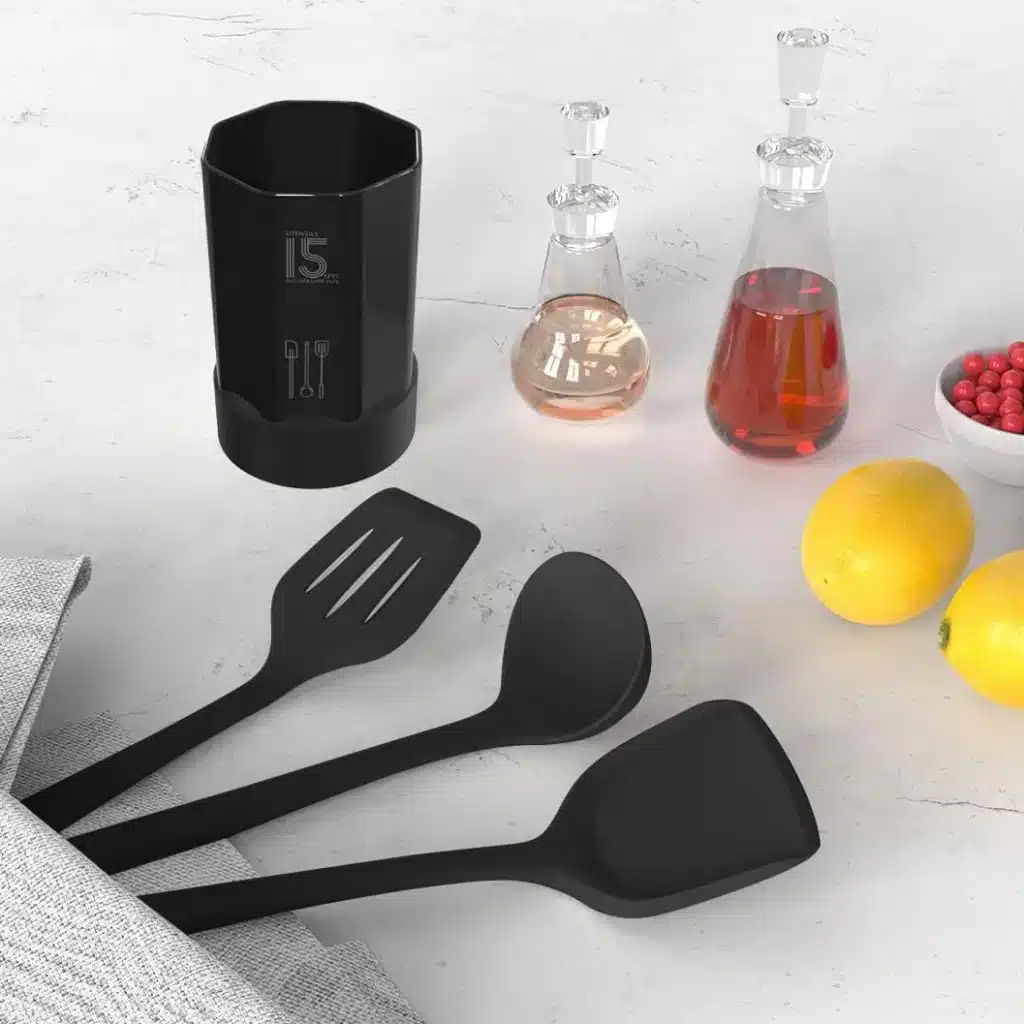Mold on kitchen utensils isn’t just an unsightly issue—it poses a significant health risk as well. Keeping your kitchen tools mold-free ensures that your food remains safe to eat and that your cooking environment maintains its aesthetic appeal.
In this comprehensive guide, we’ll explore various materials commonly used in kitchen utensils and provide tailored cleaning methods for each. From silicone and plastic to wood and metal, learn how to effectively remove mold and prevent its return, ensuring your kitchen remains a clean, safe, and inviting space.
Why Kitchen Utensils Get Moldy?
There are different reasons why your cookware might get moldy, here are some of the most common ones:
- Improper Drying: Utensils left damp after washing retain moisture, creating a favorable environment for mold growth.
- Lack of Ventilation: Storing kitchen tools in enclosed spaces without adequate airflow allows moisture to accumulate and mold to form.
- Residual Food Particles: Food remnants left on utensils can provide the necessary nutrients for mold to thrive, especially if the utensils are not cleaned thoroughly.
General Tips for Removing Mold
Before you begin the task of removing mold from kitchen utensils, it’s essential to consider your safety and the integrity of the utensils.
First and foremost, always wear protective gloves to avoid direct contact with mold, which can be harmful to your health. Ensure that the area is well-ventilated to prevent inhaling mold spores.
BUY GOOD QUALITY KITCHEN UTENSILS
Additionally, it’s crucial to identify the material of each utensil before selecting a cleaning method. Different materials require different approaches; using the wrong method can damage your kitchen tools. By following these general tips, you can effectively remove mold while protecting both your health and your kitchen utensils.
Cleaning Methods by Material
With the above in mind, we will now show you how to clean mold and mildew from your cookware according to the type of material you are using:
Silicone and Plastic Utensils:
Use a mixture of baking soda and vinegar or hydrogen peroxide for deep cleaning.
Steps:
- Create a paste from baking soda and water.
- Apply the paste to the moldy areas on the utensils.
- Let the paste sit to penetrate and break down the mold.
- Scrub the utensils thoroughly to remove all traces of mold.
- Rinse the utensils with clean water to eliminate any residue.
WHERE TO BUY SILICONE COOKWARE
Wooden Utensils
Boil in water, use vinegar and baking soda, or a combination of lemon and hydrogen peroxide for natural cleaning.
- Boil the wooden utensil in water to soften and loosen the mold.
- Scrub the utensil with a mixture of vinegar and baking soda to remove mold residues.
- For stubborn mold, apply lemon juice to the affected areas, then follow with hydrogen peroxide and scrub thoroughly
Metal and Ceramic Utensils:
- Use a bleach solution or borax paste for tough mold stains.
- Detailed Steps:
- Mix bleach with water ensuring proper dilution (typically, one part bleach to ten parts water).
- Apply the diluted bleach solution to the moldy areas on the utensils.
- Scrub thoroughly to remove the mold.
- Rinse the utensils thoroughly with clean water to remove any bleach residue.
- Alternatively, for a less harsh method, make a paste with borax and a small amount of water.
- Apply the borax paste to the mold, let it sit for a few minutes, then scrub and rinse off.
Preventing Mold Growth
However, the most effective method to have mold-free utensils is to take preventive measures. Here are some tips that can help you to avoid
Storing Utensils Properly
- Ensure all utensils are thoroughly dried before storing to prevent moisture buildup.
- Use well-ventilated drawers or racks for storage, allowing air circulation to keep utensils dry.
- Consider using silica gel packets in drawers to absorb excess moisture and further protect against mold.
Regular Cleaning and Immediate Drying
- Clean utensils immediately after use to prevent any food residues from attracting mold.
- After washing, dry utensils completely with a clean towel or let them air dry in an area with good air circulation.
- Implement a routine cleaning schedule for all kitchen tools, even those used infrequently, to maintain a mold-free environment.
When to Discard Kitchen Utensils? Handling Excessive Mold Contamination
Evaluate the extent of mold growth and the material of the utensil. Porous materials like wood may absorb mold deeply, making complete removal challenging.
If mold has penetrated deeply into the utensil or if there is a lingering smell after thorough cleaning, consider discarding the item to prevent health risks.
BUY GOOD QUALITY KITCHEN UTENSILS
For non-porous materials like metal and ceramic, if mold cannot be completely removed after several attempts with strong cleaning agents, it’s safer to replace these items to ensure kitchen hygiene and safety.
Conclusion
Recap the importance of maintaining clean, mold-free kitchen utensils for health and efficiency in the kitchen.
Encourage readers to adopt these practices and share their own tips in the comments.






